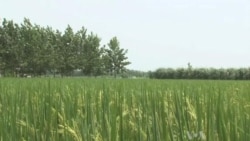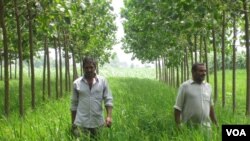INDRI, HARYANA, INDIA —
To anyone else, the patches of poplar and eucalyptus trees that dot the flat, green landscape of Indri are just added greenery.
But to farmer Chaudhry Sukhvir Singh, the trees are a fixed deposit.
"The biggest benefit is that I can plant these trees and then earn other income on the side. It’s like money being put in the bank. Anytime I need money for anything, I can cut these down and get my work done," Singh said as he removed weeds near a young sapling.
In a few years, the 500 poplar trees planted on Singh’s property in the northern state of Haryana will eventually earn him $15,000 when they are mature, cut down and sold to local plywood factories.
The farmer is among several hundred who receive support and guidance from the Nairobi-based World Agroforestry Center. The organization promotes sustainable agriculture by encouraging farmers to plant trees that produce fruit, timber, biodiesel and rubber.
In the 200-kilometer radius that stretches across Haryana, Uttarakhand and Uttar Pradesh states, some 750,000 hectares of land are being used for agroforestry projects, with trees planted right along side crops such as rice. The center hopes to have 12 to 15 million hectares of land across India under agroforestry systems in the next decade.
World Agroforestry Center Director General Tony Simons said agroforestry was key in the South Asian country, which only has about 20 percent forest cover.
"Here we have a country with 16 percent of the world’s population, 20 percent of the world’s livestock on only two percent of the world’s land and using four percent of the world’s fresh water, so we have got a problem there of sustainability," said Simons.
In India, like many other countries, more and more forests and even agricultural land are being lost to development.
"Trees are being cut, forests are being removed and the land is becoming barren. The target in India, for example, was that there should be 33 percent vegetation cover on the land," said World Agroforestry Center South Asia Director Virender Pal Singh.
He added, "there are states like Punjab and Haryana where the forest land is not 33 percent so how are we going to meet it? That can be met only when you bring the trees on the farm."
With agroforestry, farmers plant trees without affecting the growth of crops, such as wheat and sugarcane. Singh said the plants actually benefitted from improved soil fertility and water retention.
"We are getting stable productivity, a cleaner environment, increasing income, so our feeling in the country is that agroforestry is probably the only way for meeting the economic and livelihood challenges, as well as addressing the challenges of climate change," he said.
On a hot summer day like this one, farmer Chaudhry Rajender Singh feels the benefits of the microclimate his trees help create - as a cool breeze cuts through the humid air.
"There are two benefits. Pollution is less. A few days ago it was so hot, I just came and stood here [under the trees]. And we also get income from them," he said.
The World Agroforestry Center says 64 percent of India’s timber requirement is currently being met from agroforestry systems and not from forests. The organization is working with countries in Africa and Southeast Asia in hopes they will follow suit.
But to farmer Chaudhry Sukhvir Singh, the trees are a fixed deposit.
"The biggest benefit is that I can plant these trees and then earn other income on the side. It’s like money being put in the bank. Anytime I need money for anything, I can cut these down and get my work done," Singh said as he removed weeds near a young sapling.
In a few years, the 500 poplar trees planted on Singh’s property in the northern state of Haryana will eventually earn him $15,000 when they are mature, cut down and sold to local plywood factories.
The farmer is among several hundred who receive support and guidance from the Nairobi-based World Agroforestry Center. The organization promotes sustainable agriculture by encouraging farmers to plant trees that produce fruit, timber, biodiesel and rubber.
In the 200-kilometer radius that stretches across Haryana, Uttarakhand and Uttar Pradesh states, some 750,000 hectares of land are being used for agroforestry projects, with trees planted right along side crops such as rice. The center hopes to have 12 to 15 million hectares of land across India under agroforestry systems in the next decade.
World Agroforestry Center Director General Tony Simons said agroforestry was key in the South Asian country, which only has about 20 percent forest cover.
"Here we have a country with 16 percent of the world’s population, 20 percent of the world’s livestock on only two percent of the world’s land and using four percent of the world’s fresh water, so we have got a problem there of sustainability," said Simons.
In India, like many other countries, more and more forests and even agricultural land are being lost to development.
"Trees are being cut, forests are being removed and the land is becoming barren. The target in India, for example, was that there should be 33 percent vegetation cover on the land," said World Agroforestry Center South Asia Director Virender Pal Singh.
He added, "there are states like Punjab and Haryana where the forest land is not 33 percent so how are we going to meet it? That can be met only when you bring the trees on the farm."
With agroforestry, farmers plant trees without affecting the growth of crops, such as wheat and sugarcane. Singh said the plants actually benefitted from improved soil fertility and water retention.
"We are getting stable productivity, a cleaner environment, increasing income, so our feeling in the country is that agroforestry is probably the only way for meeting the economic and livelihood challenges, as well as addressing the challenges of climate change," he said.
On a hot summer day like this one, farmer Chaudhry Rajender Singh feels the benefits of the microclimate his trees help create - as a cool breeze cuts through the humid air.
"There are two benefits. Pollution is less. A few days ago it was so hot, I just came and stood here [under the trees]. And we also get income from them," he said.
The World Agroforestry Center says 64 percent of India’s timber requirement is currently being met from agroforestry systems and not from forests. The organization is working with countries in Africa and Southeast Asia in hopes they will follow suit.








